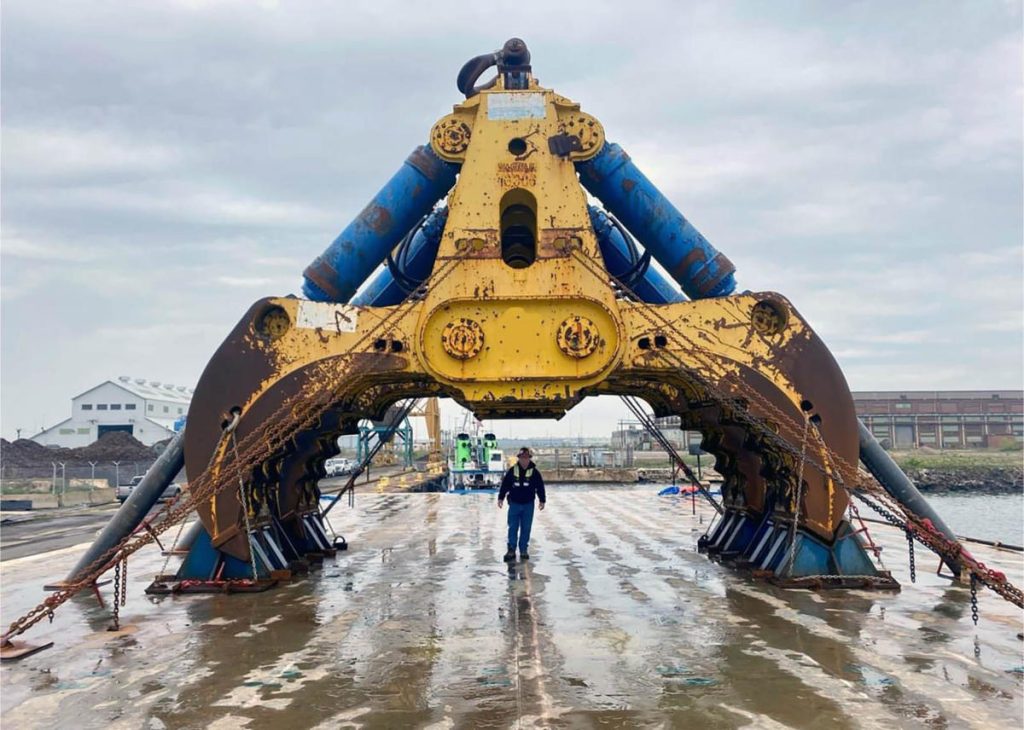The latest efforts to clear debris from the Francis Scott Key Bridge in Baltimore involve the use of a massive hydraulic grab attached to the Chesapeake 1000 crane. Weighing 165 metric tons and capable of holding up to 1,000 metric tons, this grab will play a crucial role in debris-removal operations at the bottom of the Patapsco River. As a 35-foot channel is set to open, larger vessels will be able to access the Baltimore harbor, and salvage operations will shift towards removing debris from the harbor’s main channel. The temporary Fort McHenry Limited Access Channel will be open to essential vessels starting Thursday and will close until at least May 10 to allow for dynamic salvage operations.
The hydraulic grab, manufactured by The Grab Specialist in the Netherlands, is the only one of its size in the world with four independent hydraulic claws. Built in 2015, the grab has previously been used by the global salvage firm Ardent to clear wreckage from the Troll Solution, an offshore oil rig that collapsed in 2015. The presence of this massive grab marks a crucial new phase in clearing the debris from the collapsed bridge and ensuring the safe passage of vessels through the harbor. Its arrival signifies a significant step forward in the salvage operations and the ultimate goal of fully clearing the channel for maritime traffic.
The Fort McHenry Limited Access Channel is expected to open for commercially essential vessels from Thursday onwards, and will remain closed after Monday morning until at least May 10 to allow for critical salvage operations. Vessels wishing to navigate this channel will need to comply with specific requirements based on their size and other factors, such as being helmed by a Maryland pilot and escorted by two tugboats. The Coast Guard has issued a marine safety bulletin outlining the procedures and guidelines for vessels using the channel, with a focus on safety and efficiency during the salvage operations.
The alternating opening and closing of the temporary channel is necessary to facilitate the ongoing salvage efforts and adapt to the changing conditions in the water. The colossal size and capabilities of the hydraulic grab will necessitate adjustments to the salvage operations in order to effectively remove subsurface debris from the Patapsco River. This equipment, previously on standby during salvage operations in different locations, will now be put to use in clearing the wreckage and debris from the collapsed bridge. The presence of this advanced technology indicates a coordinated and strategic approach to salvage operations in Baltimore harbor.
The salvage operations at the Francis Scott Key Bridge site have been ongoing since the collapse of the bridge due to a cargo ship striking a support column on March 26, resulting in the deaths of six construction workers. The efforts to clear the debris and restore access to the Baltimore harbor have been complex and required a multi-faceted approach involving multiple stakeholders. The utilization of advanced equipment such as the hydraulic grab demonstrates a commitment to efficient and effective debris removal, ensuring the safety of maritime traffic in the area. As salvage operations continue, the focus remains on safely reopening the main channel and restoring normal operations in the harbor.
The successful operation of the hydraulic grab and the opening of the Fort McHenry Limited Access Channel represent significant milestones in the salvage efforts following the collapse of the Key Bridge. The coordination of multiple agencies and organizations, as well as the utilization of specialized equipment, highlights the importance of a comprehensive approach to debris removal and salvage operations in complex maritime incidents. The efforts to clear the wreckage and debris from the river and harbor are crucial to restoring normal operations and ensuring the safety and efficiency of maritime traffic in the area. As the salvage operations progress, continued collaboration and innovation will be key to successfully overcoming the challenges posed by the collapsed bridge and facilitating the reopening of the main channel for vessels of all sizes.


